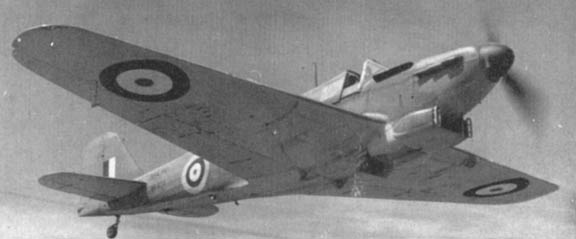|
|



The first Fulmar I (N1854).
|
NOTES: The Fulmar evolved from a 1937 Fleet Air Arm specification for a folding wing shipboard fighter with firepower equal to the Hurricane and Spitfire then coming into service. Fairey decided to meet the specification (0.8/38) by refining an earlier design that was essentially a lightened Fairey Battle. Externally the Fulmar resembled the Battle but internally the aircraft was significantly different. The structure was lightened further and folding wings were installed. Additional changes included installing arrester gear, naval equipment and strengthening the structure to handle catapult attachment points. As a result of an Admiralty belief that accurate navigation by the pilot was impossible with current navigational aids, the specification included provisions for a navigator and his equipment. No aircraft were built as specific prototypes but the first three aircraft off the production line were used for trials. The first aircraft (N1854) flew for the first time on January 4, 1940 with the second aircraft (N1855) flying on April 6, 1940. N1855 was delivered to Boscome Downs on May 3rd while the third aircraft (N1856) was delivered to the Service Trial Unit at Lee-On-Solent on May 10, 1940. After an initially slow start, production moved into high gear after the third aircraft with eleven aircraft being completed by June 17, 1940. The Fulmar entered squadron service a month later with No. 806 Squadron reforming with twelve aircraft in July. After thier initial work up the squadron was deployed to the Mediterranean aboard the H.M.S. Illustrious in August 1940. By September the squadron was seeing combat against aircraft from the Regia Aeronautica while protecting Malta bound convoys. Use of the Fulmar rapidly expanded with two additional squadrons, Nos. 807 & 808, being formed by the end of 1940. Five additional squadrons entered service the following year and six more squadrons forming by the closing days of 1942. The Fulmar provided useful service in the Mediterranean where it faced the obsolete aircraft of the Regia Aeronautica and it's relatively low speed was less of a liability. The Fulmar served in a variety of roles including convoy escort, nightfighter and night intruder roles, the last while serving with No. 800X Squadron on Malta from May to November of 1941. A Fulmar became one of the first fighters to be launched from an armed merchantman, the Afriquani, during an Atlantic convoy crossing. In early 1941 an Fulmar I was fitted with a Merlin 30 in an attempt to increase performance. This aircraft flew for the first time on January 30, 1941 and proved to be somewhat successful. This aircraft was fitted with tropical equipment and became the prototype for the Fulmar II with the first aircraft being X8525. Three hundred and fifty Fulmar IIs were built withe the last aircraft (DR749) coming off the assembly line in February 1943. Though the more powerful engine increased the Fulmars top speed, by 1943 the design was for the most part obsolete and fell easy prey to more modern fighters. The aircraft was slowly withdrawn from service as more modern British designs became available. At least one flight of Fulmar II nightfighters remained in service with No. 803 squadron until early 1945, providing escort for Russian bound convoys. |


